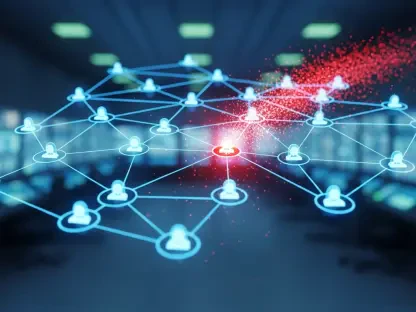A recent wave of hyper-volumetric Distributed Denial-of-Service (DDoS) attacks, powered by Mirai botnets, has illuminated ongoing vulnerabilities in IoT devices and underscored the significant threat landscape for cybersecurity. The enduring issue was laid bare through a record-breaking 5.6 Tbps attack perpetrated by a Mirai botnet involving over 13,000 compromised Internet of Things (IoT) devices. This brief but intense attack hurled an enormous volume of traffic at an Eastern Asian internet service provider, underscoring the urgency for improved IoT security practices.
The Scale and Impact of the Attack
Record-Breaking DDoS Assault
The 5.6 Tbps attack, the largest of its kind, demonstrated the devastating potential of compromised IoT devices. Each device contributed an average of just over 1 Gbps per second, showcasing the collective impact of even seemingly benign devices when commandeered en masse. This attack targeted an Eastern Asian internet service provider, causing significant disruption and highlighting the need for robust defense mechanisms. The immense scale of this attack serves as a stark reminder of the vulnerabilities inherent in IoT ecosystems, emphasizing the critical need for improved security measures to prevent such massive breaches in the future.
As these devices become more widespread, the potential for large-scale disruptions grows exponentially, making it imperative for manufacturers, ISPs, and end-users to adopt stringent security protocols. The repercussions of such attacks can extend beyond immediate service disruptions, potentially leading to financial losses, reputational damage, and a strained digital infrastructure. This incident underscores the urgent necessity for concerted efforts to enhance IoT security and stave off similar attacks, thus safeguarding the integrity of our internet-connected world.
Cloudflare’s Automated Defense
Cloudflare’s autonomous, distributed defense systems successfully neutralized the attack in real-time without human intervention or noticeable disruption. This points to the robustness and efficiency of automated defense mechanisms and highlights a key trend in cybersecurity: the shift towards autonomous threat detection and mitigation. The success of Cloudflare’s systems underscores the importance of rapid-response mitigation in handling swift and massive DDoS attacks. This capability is crucial in the current cyber threat landscape, where the speed and scale of attacks are increasing at an alarming rate.
The ability of Cloudflare’s systems to fend off a massive attack with such efficiency showcases the critical role of advanced technology in cybersecurity. As DDoS attacks become more sophisticated, the traditional reactive approach is no longer sufficient. Instead, proactive and automated defense mechanisms are essential to identify and neutralize threats in real-time. This shift towards automation is not just a trend but a necessity, calling for investment in advanced defense technologies to stay ahead in the cyber defense realm.
Persistent IoT Vulnerabilities
Exploitation of IoT Devices
The article delves into the persistent and evolving problem of IoT vulnerabilities. These devices, often exploited due to default credentials or outdated firmware, provide fertile ground for botnet operations. Security shortcomings of IoT devices enable them to be easily co-opted into vast and malicious botnets, posing a substantial threat to the broader internet ecosystem. Despite increased awareness, many IoT devices remain inadequately secured, with default passwords and widely-known exploits still commonplace. This oversight creates an environment where these devices can be easily hijacked and turned into tools of mass disruption.
Manufacturers and end-users must prioritize security by ensuring that firmware is regularly updated and that strong, unique credentials replace factory defaults. The responsibility for securing IoT devices lies at multiple levels, from the design phase to ongoing maintenance. Implementing these changes requires a combined effort involving industry standards, regulatory policies, and increased public awareness. The consequences of neglect are evident in the ease with which botnets capitalize on these vulnerabilities, adding urgency to the need for comprehensive security solutions.
Need for Stronger Security Standards
This reinforces ongoing security concerns and calls for stronger IoT device security standards and proactive vulnerability management. Improved security practices, including regular firmware updates and the use of strong, unique credentials, are essential to prevent IoT devices from being compromised and used in large-scale attacks. Industry stakeholders must collaborate to establish and enforce stringent security protocols and standards, thereby ensuring that devices are resilient against exploitation. Manufacturers, in particular, must adopt a security-first approach in the design and deployment of their products.
Moreover, policymakers need to incentivize and perhaps even mandate higher security standards in the IoT industry. Without external pressures, there is little motivation for device makers to prioritize robust security, as the market often values cost and functionality over protection. Customers also play a crucial role; by prioritizing secure IoT purchases and demanding better security features, they can drive meaningful improvements across the sector. The combined efforts of all parties involved could significantly mitigate the risks and reduce the prevalence of botnet-enabled DDoS attacks.
Escalating Frequency and Intensity of DDoS Attacks
Dramatic Increase in Attack Volume
The fourth quarter of 2024 witnessed a staggering 1,885% increase in hyper-volumetric DDoS attacks exceeding 1 Tbps on a quarter-on-quarter basis. Additionally, attacks exceeding 100 million packets per second (pps) saw a significant 175% rise over the same period, with 16% of these surpassing the astronomical threshold of 1 billion pps. This escalation emphasizes the increasing sophistication and scale of modern DDoS attacks. These statistics reveal a troubling trend that highlights not just the frequency but also the intensity and coordination of cyber threats facing global digital infrastructure.
Such an exponential rise in both the volume and velocity of attacks suggests a deliberate and sophisticated effort by malicious actors to compromise systems across various sectors. Organizations are facing an ever-evolving threat landscape that necessitates both vigilance and proactive measures to counteract these formidable threats. This unprecedented growth in attack size and complexity underscores the necessity for organizations to stay abreast of emerging threats and continually refine their defensive strategies.
Challenges of Small-Scale, Brief Attacks
Despite the enormous scale of certain attacks, most network-layer DDoS attacks remain relatively small. Cloudflare’s data shows that 93% of such attacks are under 500 Mbps. However, the brevity of these assaults poses its own challenges—91% of network-layer DDoS attacks end within ten minutes, leaving little time for a human response. This reality further underscores the necessity for automated and rapid-response mitigation systems to handle the swift nature of such threats effectively. These short-duration attacks can be particularly insidious, as their quick execution often circumvents traditional defense mechanisms, making their detection and mitigation a specialized task.
The shift towards smaller but more frequent attacks signals a tactical change by attackers to overwhelm defenses without laying a sustained onslaught. Given their brief nature, these attacks exploit gaps in preparedness and response times, emphasizing the critical need for enhanced real-time detection capabilities. As attackers continually refine their methods, cybersecurity measures must evolve accordingly, ensuring that even the smallest attacks are swiftly identified and neutralized.
Geographical and Sectoral Analysis of DDoS Attacks
Source of Attacks
Geographically, the source of DDoS attacks shows some interesting patterns. Indonesia has continued to be the largest source of attacks, with Hong Kong and Singapore following. For HTTP DDoS attacks, this geographical source can be identified through the IP addresses of compromised devices, while for network-layer attacks, Cloudflare relies on its global network of data centers to determine the origin of attack traffic accurately. This ensures precise attribution even in the face of tactics like IP spoofing. Understanding the geographical distribution of these attacks allows cybersecurity experts to pinpoint hotspots and develop localized strategies to mitigate threats.
The data underscores the global nature of the DDoS threat, revealing that no region is immune to these cyber onslaughts. As attack patterns evolve, regional trends provide valuable insights into where defenses might need bolstering. By identifying the primary sources of attacks, organizations can tailor their defenses to anticipate and counteract threats more effectively. This geographical analysis also highlights the importance of international cooperation in combating the pervasive and borderless nature of cyber threats.
Targeted Countries and Sectors
China remains the most attacked country as per the billing addresses of Cloudflare’s target clients, with the Philippines and Taiwan rapidly rising in the ranks. Industry-wise, the ‘Telecommunications, Service Providers, and Carriers’ sector has seen the highest number of attacks, dethroning the banking and financial services, which previously held this unenviable position. The ‘Internet and Marketing & Advertising’ sector follows closely, indicating that the threat of DDoS attacks is pervasive and spans various industries. This shift underscores the broadening target base of DDoS attacks, reflecting attackers’ strategies to exploit vulnerabilities across different sectors.
The rising number of attacks against telecommunications and service providers is particularly alarming, given the critical infrastructure these sectors represent. Disruptions in these industries can have far-reaching consequences, impacting communication systems and essential services critical to societal functioning. The data suggests a strategic targeting of sectors ostensibly integral to both daily operations and national security. It underscores the urgent need for sector-specific defensive measures and robust collaboration between targeted industries and cybersecurity firms.
Attribution and Motivations Behind Attacks
Identifying Attackers
Cloudflare’s clients often remain unsure of who precisely is behind the attacks. Among those who have identified attackers, 40% pointed to competitors, indicating a significant issue with industrial sabotage. Other notable sources include state or state-sponsored actors (17%), disgruntled individuals such as ex-employees or customers, and extortionists driving ransom-based DDoS attacks (or RDoS). This diversity in attackers adds layers of complexity to both identifying and responding to threats, as motivations and strategies can vary significantly across different perpetrators.
The involvement of state-sponsored actors points to a darker, more systematic side of cyber threats that transcends typical criminal activities. These state-driven campaigns often have geopolitical implications, requiring cooperation between governments, international bodies, and private entities to address the broader national security concerns. The rise in competitor-driven attacks highlights a more cynical aspect of business rivalries where digital sabotage has become a weapon of choice in undermining opponents. Both situations call for heightened awareness and preparedness at all levels.
Motivations and Implications
A recent surge of hyper-volumetric Distributed Denial-of-Service (DDoS) attacks, facilitated by Mirai botnets, has highlighted persistent vulnerabilities in Internet of Things (IoT) devices and underscored the substantial threat these pose to cybersecurity. This longstanding issue was starkly exposed by a record-breaking attack that reached 5.6 Tbps, orchestrated by a Mirai botnet comprising over 13,000 compromised IoT devices. This brief but highly intense attack directed an enormous volume of traffic at an internet service provider in Eastern Asia, emphasizing the critical need for enhanced security measures for IoT devices. The record-breaking scale of this attack serves as a potent reminder that cybersecurity practices must evolve to address the vulnerabilities of IoT systems effectively. The key takeaway from this event is the undeniable necessity for more rigorous security protocols and practices to safeguard against such overwhelming threats, illustrating the pressing need for improvements in IoT security to prevent similar incidents in the future.









